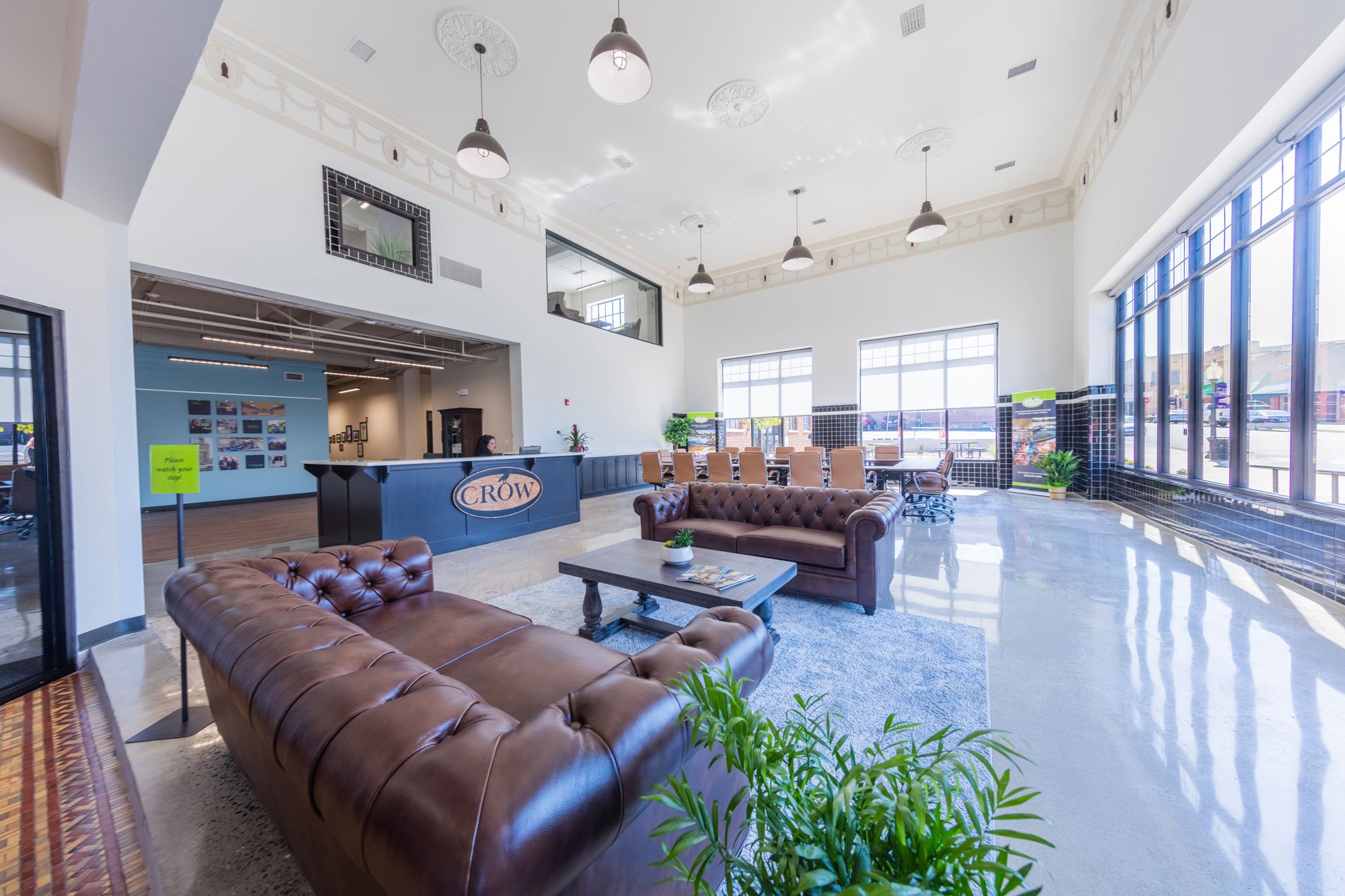A Coca-Cola bottling plant in Morrilton goes corporate.
By Amber Jones
Old abandoned Coca-Cola Building in Morrilton.
© LIZ CHRISMAN
Crow Group Inc. purchased the building long known as the Coca-Cola Building from the city of Morrilton in 2018. The building was originally constructed in 1929 as a Coca-Cola bottling plant and was also the site of the original Morrilton Walmart Number 8 Store in the 1960s. More recently, the building served as Morrilton City Hall and the Morrilton Police Department for 40 years. When the city purchased it in 1978, they installed acoustic tile drop ceilings, golden wood paneling for walls, and linoleum and carpet for the floors. Many areas were divided into smaller office spaces to suit the needs of the city at that time, which also included installing more than 20 jail cells made of concrete and steel.
Crow Group’s headquarters lobby.
© LIZ CHRISMAN
Old Coca-Cola bottling room before the renovation.
© LIZ CHRISMAN
A surprise was discovered in the area that had been used as the judge’s bench and courtroom. The remnants of the original bottling room were revealed with the removal of the drop ceiling and wood paneling. Another set of photos was taken to document the find for the National Park Service.
The building was nominated to the National Register of Historic Places in 1984 based on its exterior Colonial Revival and Art Deco architectural features. It helped that the building was designed by the prolific Arkansas architectural firm of Thompson, Sanders and Ginocchio and there was a federal push to nominate buildings to the National Register at that time. The interior of the building was not even mentioned in the nomination, of course, because at that time there was nothing visible worth mentioning.
One set of photos was taken to document the existing conditions of the building to apply for federal and state historic tax credits. Selective demolition removed all of the wood wall paneling, carpet, linoleum, drop ceilings and multiple tons of concrete and steel that made up the jail cells. A surprise was discovered in the area that had been used as the judge’s bench and courtroom. The remnants of the original bottling room were revealed with the removal of the drop ceiling and wood paneling. Another set of photos was taken to document the find for the National Park Service.
A plaster frieze depicting life-size Coca-Cola bottles inside plaster medallions surrounded the room at the ceiling. The frieze also contained florals and draping cords depicted from plaster. Black with white ceramic tile was on the walls to about six feet from the floor; no one, however, wants a conference room with black tile on the wall, and this was certainly not in Crow Group’s plans. Knowing that the building was designed by a Charles Thompson firm, the Old State House Museum was consulted to locate the original plans. Meanwhile, Brian Rohlman with Crow Group was rethinking its plan and how the firm could make this new development work. He knew he had found something very special with the discovery of the bottling room. The original 1929 plans were found and architect Terry Burrus used them to replicate missing elements of the bottling room frieze and wall tile. The plans were also instrumental in recreating the front facade windows and mullions, which had been changed out to louvered windows. The modern aluminum commercial front door was removed in favor of crafting and recreating a new wood front door from the original plans. Period lighting was researched and pendants similar to the original were purchased and installed at their original locations. Adjacent to the bottling room, the original mosaic tile floor was discovered under layers of linoleum and mastic. What seemed impossible became reality: With a lot of elbow grease, Crow Group construction workers managed to excavate the tile floor in the main entry from decades of mastic. The restored mosaic tile floor is the perfect entryway into the restored bottling room, which now serves as a conference room at Crow Group headquarters.
Many steel frame windows throughout the 20,000-square-foot building were in disrepair, painted to obscure light or boarded up entirely. The window openings were returned to the building and the existing steel frame windows and glass were restored, while the missing windows were fabricated from the original plans, restoring the original exterior envelope of the building.
The original yellow terra cotta block interior wall of the Walmart side of the building was restored and incorporated into the office design. The concrete shear wall below the block was allowed to be covered by the National Park Service to allow wiring and cable for modern office use to be installed and hidden. Initially Rholman, the president at Crow Group, was not thrilled with leaving this block exposed, but admitted recently that he really liked the block and is glad he was convinced to leave it in place. The historic feature is complemented by the new offices. Additional improvements included adding solar panels to the roof of the building, an investment that was aided by a USDA grant, federal energy tax credits, and federal and state historic tax credits.
Not only did Crow Group meet the surprise challenge of restoring the bottling room with their Coca-Cola Building project, they gained approval from the National Park Service and a modest compliment — an email reading “nice job” from the reviewer who literally wrote the book on preservation standards.
Amber Jones is an historic preservation tax credit consultant.




